Riparian planting
4 min read
Riparian planting can improve your farm's environmental performance. Whether it’s a river, drain, stream, wetland, lake or pond, planting at the water’s edge has many benefits. The plants in these areas act as a filter and stabiliser, decreasing erosion and run-off to protect water quality. They can also boost the health of plants, fish and animals in and around the water.
Riparian planting is one of the best tools farmers have to protect water quality. Plants act as natural filters, trapping nutrients like nitrogen and phosphorus, as well as sediment and bacteria, before they reach waterways. This reduces the risk of algal blooms and nuisance weeds, while supporting healthy fish and insect life. Get the maximum benefits by planting areas on your farm that are often wet or boggy. These are areas where there's usually a higher concentration of contaminants.
Visit nutrients and contaminants to find out more.

Some sediment movement is natural, but too much can smother organisms living in the waterway and impacts your paddock soils. Riparian planting stabilises banks and reduces erosion. Strong root systems along the bank hold soil in place, protecting freshwater habitats and keeping soil in the paddock boosting farm resilience.
Visit Reduce sediment loss to find out more.
Once established, riparian plants shade the water and lower its temperature, reducing weed and algae growth and providing stable temperatures for aquatic life.
Without shade, the water temperature can fluctuate, and New Zealand native fish generally can't tolerate temperatures above 25°C. Warmer water temperatures can also lead to increased aquatic plant and algae growth. This can then clog the water flow, decreasing oxygen levels needed by native fish and invertebrate communities.

Riparian areas offer diverse habitats for different native species. The roots provide hiding and spawning spots for essential native species. Plants also provide overhanging habitat and a source of food for aquatic animals. All species contribute to the overall health of the ecosystem, and greater biodiversity helps make the system more stable and resilient to stresses such as temperature changes and pests.
Visit Biodiversity for more information.
Increasing native planting on farms doesn’t just improve the environment; it builds pride. Planting makes a visible difference to the landscapes and communities notice too. It’s a sign of care and commitment, showing that farming and nature can thrive together. That sense of shared achievement strengthens connections between farmers, neighbours, and the wider rural community.
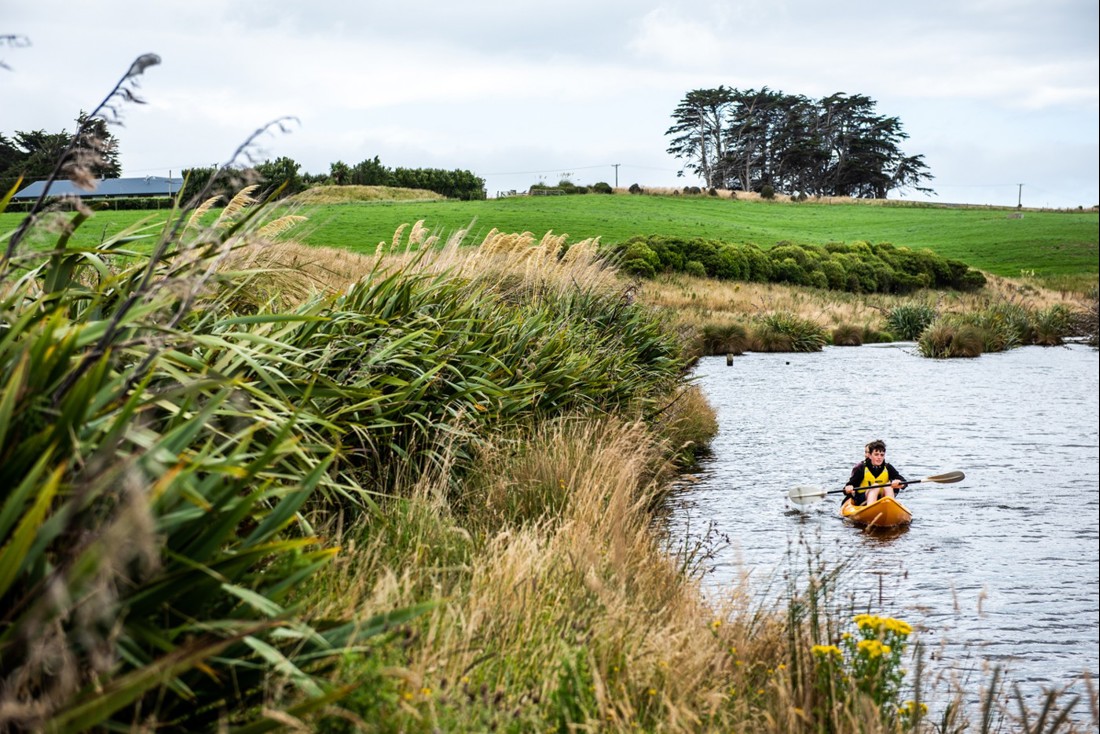
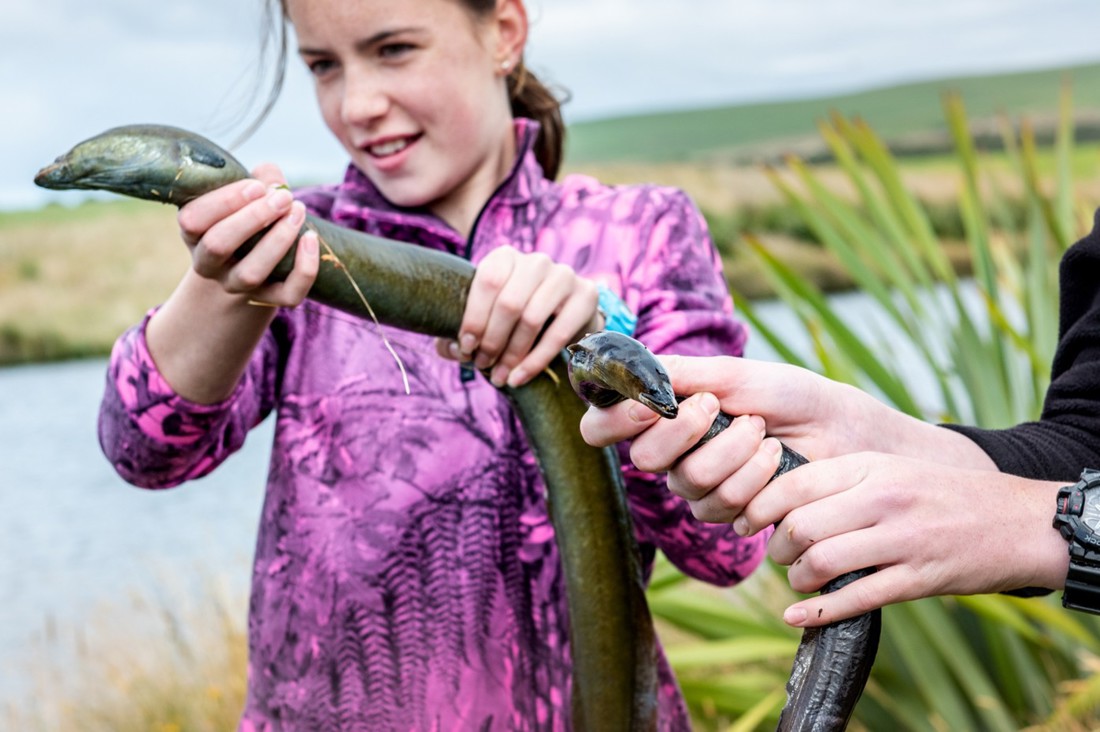
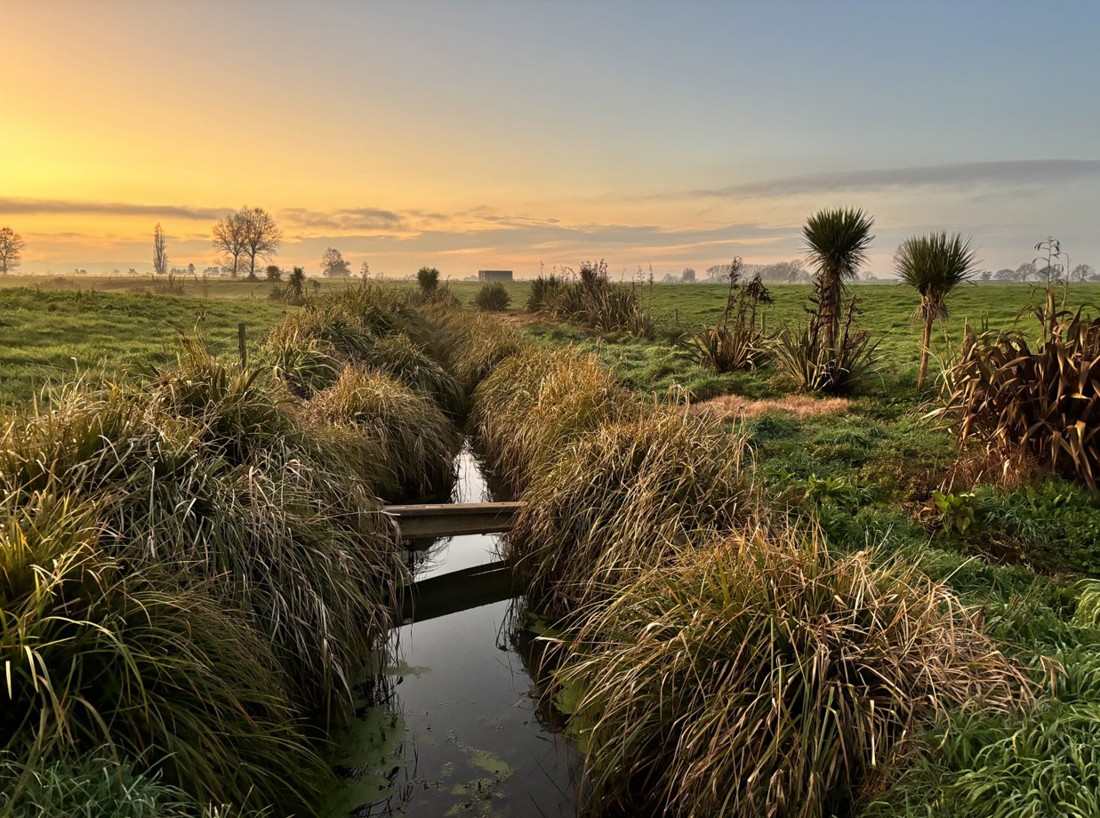

I’m watching the trees grow every day. We go back there just to sit and admire it. That’s one of the things I didn’t think we would do as often as we do.
Farmer quote
Understanding your site
Get advice
Plan your planting
Prepare the site
Plant and protect
Maintain it
There are three distinct planting zones in riparian margins, each serving a unique purpose and needing different plant species.
Grass strip
Grass strips should be left between riparian planting and fences to prevent plants from tripping electric wires. Also, leave rank grass in areas where swales enter waterways.
Upper bank zone
The upper bank zone is on higher ground but may remain partially flooded every couple of years. Use flaxes, grasses, shrubs, or trees that provide shade and shelter to the waterway channel.
Lower bank zone
The lower bank zone is prone to flooding, so plants need to be tolerant of waterlogging. Use well-rooted plants such as sedges and rushes, which can survive many days under water. Plant close to the waterway edge to provide important overhanging habitat for animals living in the waterways.
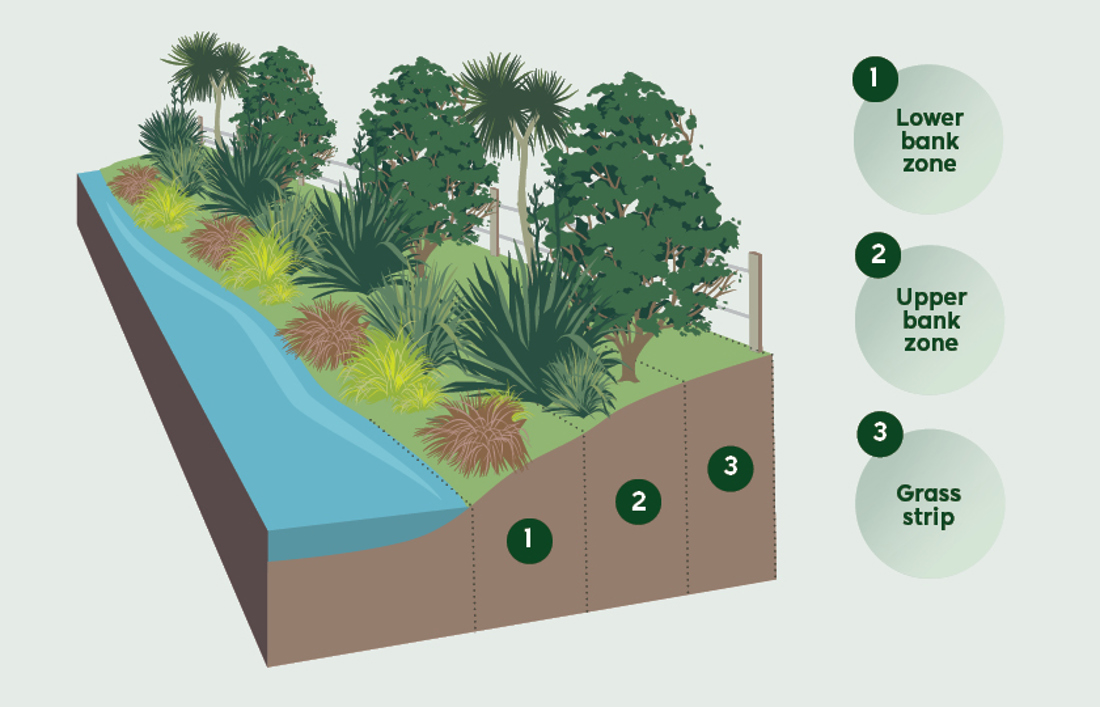
Riparian planting provides shade which creates many benefits; such as reduced water temperatures, less weed and algae growth, and improved aquatic habitats.
For these benefits to be fully achieved, rivers require a minimum of 70 percent shade coverage. When deciding what to plant and how wide the riparian margin should be, it's crucial to consider the orientation of the waterway.
| Both banks planted | One bank planted |
| North-south flowing stream Plant height needs to be a least 80% of the stream width. |
North-south flowing stream Planting on one bank does not achieve 70% shade for aquatic weed control, but it is likely to slow aquatic weed growth and improve water temperature and quality. |
| East-west flowing stream Plant height needs to be at least one and a half times the stream width. |
East-west flowing stream Plant height should be three times the stream width, with an overarching canopy. Taller vegetation is recommended on the north bank. |
| Meandering stream Plant height needs to be at least 75% of the stream width. |
To create more shade Use taller plants, overhanging vegetation, and/or plant along meandering channels to increase shade. |


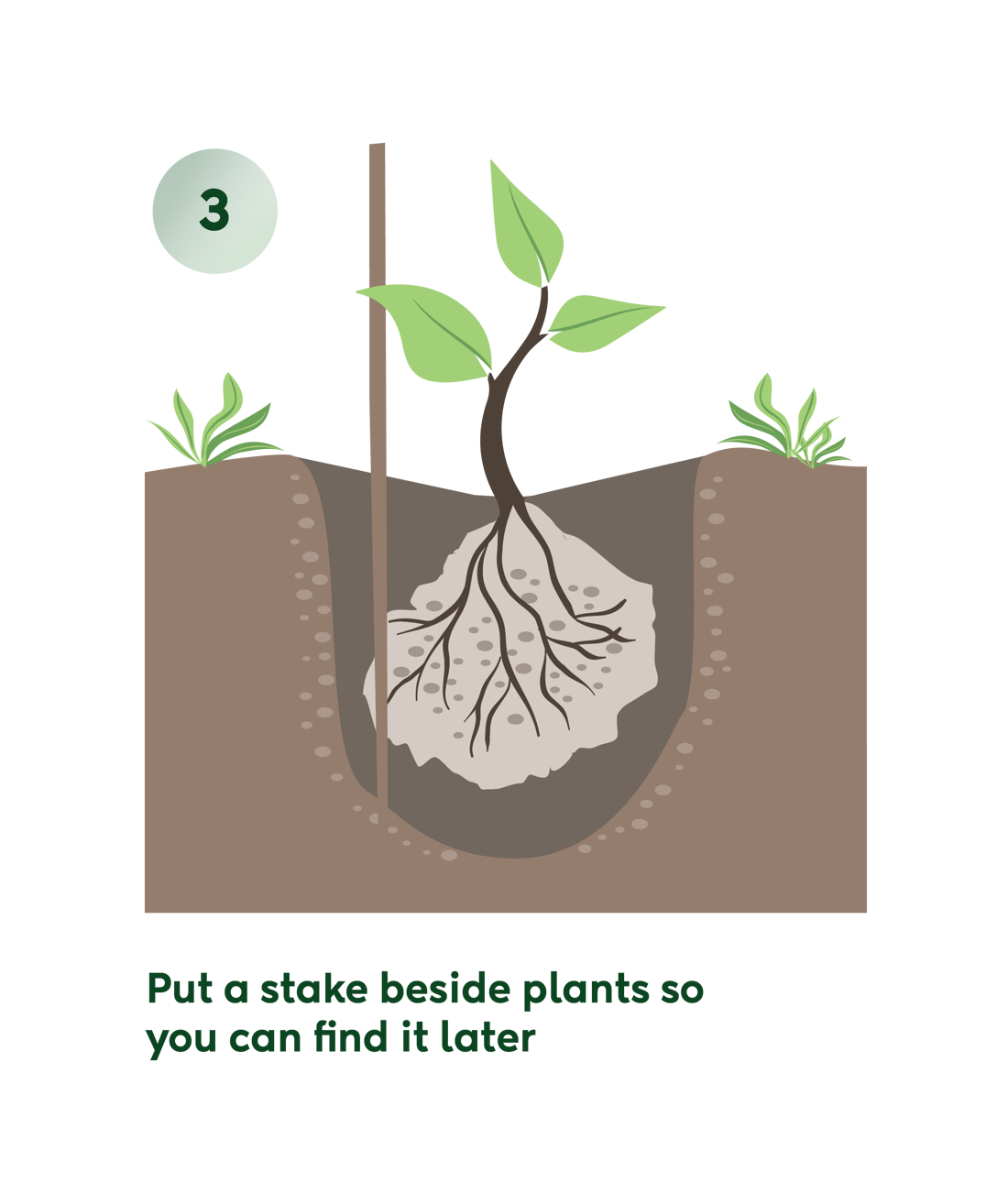

Keeping on top of weeds and pests is crucial in the first five years for establishing a healthy riparian area. The most effective maintenance option combines protective and active maintenance methods.
Applying protective measures
Surround each plant with 30–40 cm of biodegradable weed mat, mulch, or old woollen carpet to suppress weeds. Avoid plain wood chips, which can deplete soil nitrogen and harm the plant.
Active maintenance
Control weeds twice a year by brush cutting, hand weeding, or careful glyphosate spraying. If spraying, follow product guidelines - desired plants are usually sensitive to herbicides, so caution must be taken to protect against spray drift.
'Plant releasing' means clearing the area around a newly planted tree or plant from grass and weeds. This ensures the plant has space, light, water, and nutrients to grow without being crowded or smothered. It’s an important step in successful re-vegetation.
Watch the video below to learn about three plant-releasing techniques to make your riparian planting a success.

Individual plantings are a great first step for protecting and enhancing a waterway. However, getting together with your neighbours and taking a whole catchment view is the most impactful way you can improve your waterways. DairyNZ has a great range of resources for starting and maintaining catchment groups. Visit DairyNZ catchment group support for more information.
Find a catchment group near you on the map of Catchment and Environmental Community Groups.
Riparian planting could be an action to consider as part of your Freshwater Farm Plan. For more information visit the Freshwater farm plans page.
Now’s the perfect time to check in, plan, and set up for a strong season. We’ve pulled together smart tips and tools to help you stay ahead all winter long.
Whether you prefer to read, listen, or download handy guides, we’ve got you covered with trusted tools to support your journey every step of the way.
Put our proven strategies and seasonal tools to work. Boost production, support animal health and watch your profits hum.
Tools that are backed by science, shaped by farmers and made for this season.
That’s Summer Smarts.